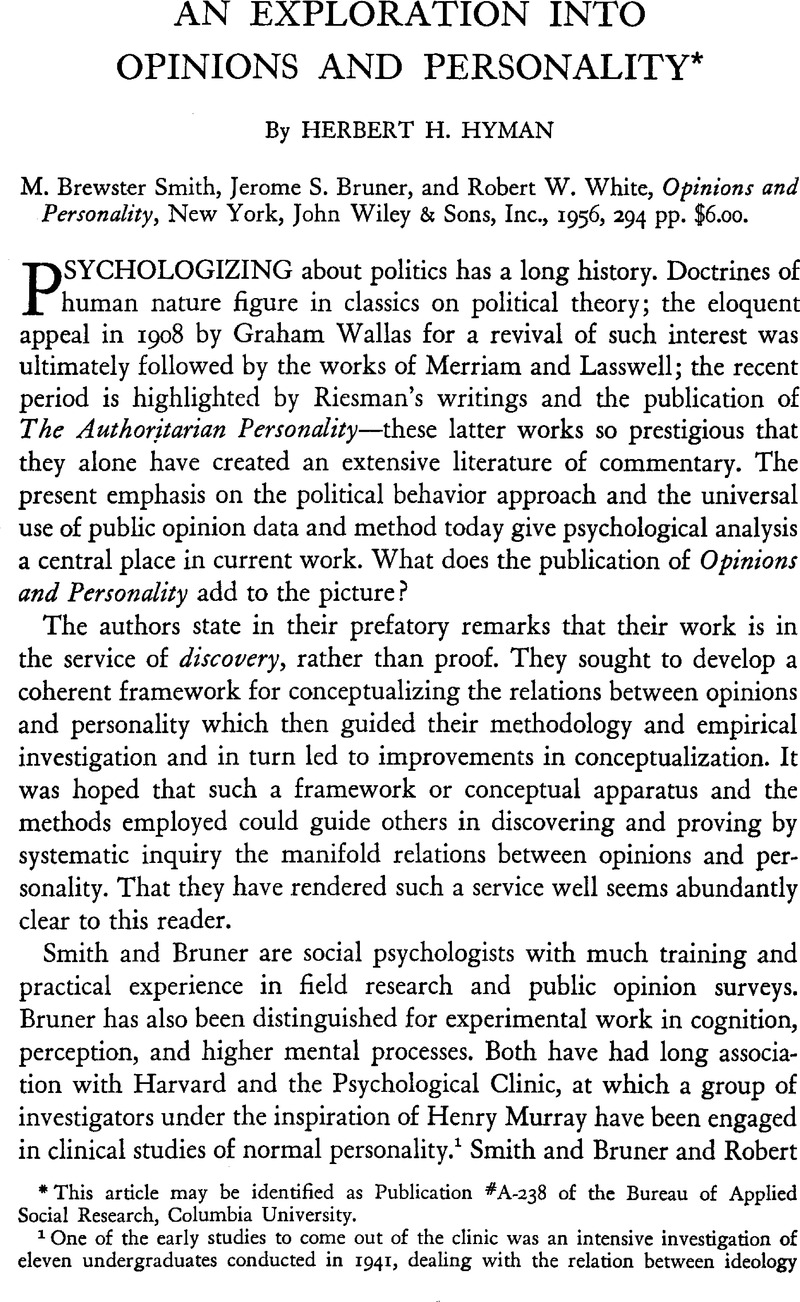Article contents
An Exploration into Opinions and Personality*
Review products
Published online by Cambridge University Press: 18 July 2011
Abstract

- Type
- Review Articles
- Information
- Copyright
- Copyright © Trustees of Princeton University 1957
References
1 One of the early studies to come out of the clinic was an intensive investigation of eleven undergraduates conducted in 1941, dealing with the relation between ideology and personality. See Murray, H. and Morgan, C., “A Clinical Study of Sentiments,” Genetic Psychology Monographs, XXXII (1945), pp. 3–149, 153–311.Google Scholar
2 Lippmann, Walter, Public Opinion, New York, 1922Google Scholar; Krech, D. and Crutchfield, R., Theory and Problems of Social Psychology, New York, 1949Google Scholar, Part II.
3 See an earlier publication based on the same inquiry: Smith, M. B., “The Personal Setting of Public Opinions,” Public Opinion Quarterly, XI (Winter 1947–1948), pp. 507–23.CrossRefGoogle Scholar
4 An earlier paper growing out of the larger project discusses some of these matters. See Bauer, R. and Riecken, H., “Opinion in Relation to Personality and Social Organization,” International Journal of Opinion Attitude Research, III (1949–1950), pp. 513–29.Google Scholar
5 For a definitive treatment and critique of the literature of this period, see Murphy, G., Murphy, L., and Newcomb, T., Experimental Social Psychology, rev. ed., New York, 1937Google Scholar, ch. 13.
6 A striking parallel is found in a program of research under Daniel Katz at the University of Michigan, in which the same three functions of attitude are elaborated independently and empirical evidence is provided that changing an individual's opinions requires the choice of a method appropriate to the particular function of opinion that predominates. See, e.g., Sarnoff, I., Katz, D., and McClintock, C., “Attitude-Change Procedures and Motivating Patterns,” in Katz, D., et al., Public Opinion and Propaganda, New York, 1954, pp. 305–12.Google Scholar
7 For a summary of such studies, see Klapper, J., “The Effects of Mass Media,” New York, Bureau of Applied Social Research, Columbia University, 1949, mimeo.Google Scholar
8 Such concepts would perhaps help to predict when opinions might issue into action. See Krech and Crutchfield, op. cit., for a more elaborate set of concepts to describe the orientation aspect of opinions.
9 In an earlier paper growing out of the present inquiry, Smith deals extensively with values, elaborating propositions and evidence as to the conditions under which values become engaged by particular objects of opinion. See Smith, M. B., “Personal Values as Determinants of a Political Attitude,” Journal of Psychology, XXVIII (1949), pp. 477–86.CrossRefGoogle Scholar
10 It should be noted, however, mat as a result of this inquiry, and using a more limited battery of procedures, Smith sought to test the generality of the theory by a two-wave panel study conducted on a sample of 250 males representing a New England community (ibid.). One regrets the lack of an incorporation into the present book of at least a brief report on these more extensive empirical findings.
- 3
- Cited by


